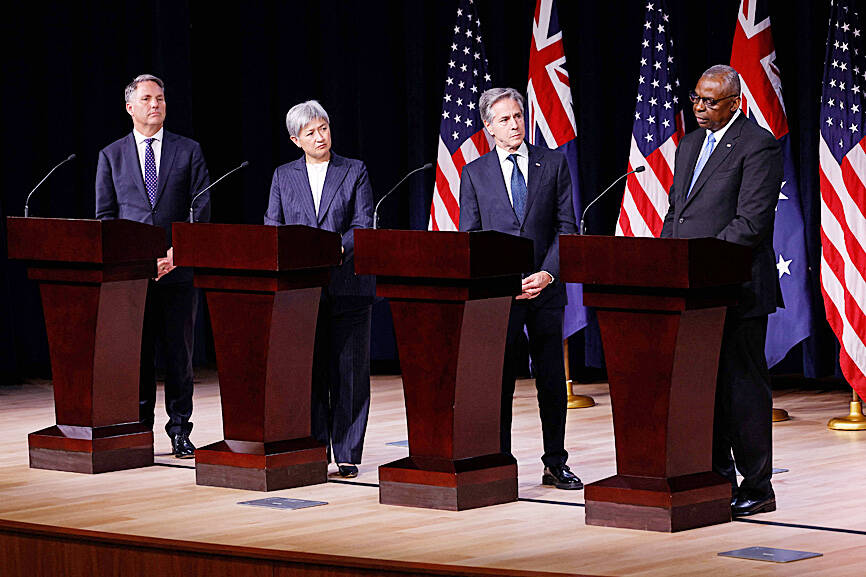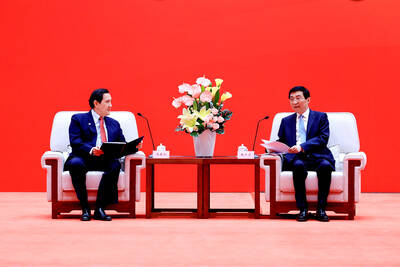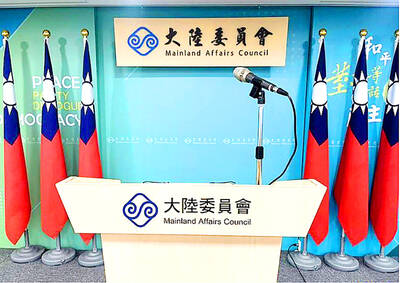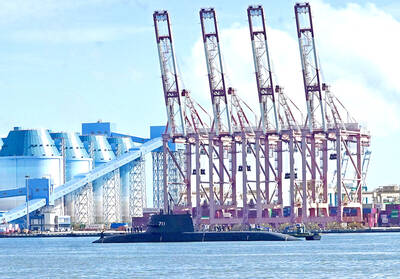The US and Australia yesterday issued a joint statement to emphasize the role of the two nations’ defensive alliance in securing peace and prosperity in the Indo-Pacific region, including countering Chinese aggression toward Taiwan.
The statement followed a ministers’ summit in Annapolis, Maryland, on Tuesday attended by US Secretary of State Antony Blinken, US Secretary of Defense Lloyd Austin, Australian Minister for Foreign Affairs Penny Wong (黃英賢) and Australian Deputy Prime Minister and Minister for Defence Richard Marles.
The ministers affirmed the importance of maintaining peace and stability across the Taiwan Strait, their opposition to unilateral changes to the “status quo,” and called for the peaceful solution of differences without using force or coercion.

Photo: AFP
The US and Australia expressed “strong concern regarding China’s military and coast guard activity around Taiwan,” they said, adding that their governments are committed to Taiwan’s “meaningful participation in international organizations.”
In Taipei, the Ministry of Foreign Affairs thanked the US and Australia for supporting Taiwan at the annual Australia-US Ministerial Consultations over the past five years.
Taiwan thanked the ministers for unequivocally registering their concern over the provocative actions of the Chinese People’s Liberation Army and the China Coast Guard around Taiwan, it said.
The deluge of joint statements from the ministerial consultations of the US and like-minded countries is evidence of a global consensus about the importance of maintaining Taiwan’s security, the ministry said.
“Taiwan is a responsible member of the Indo-Pacific region and will continue to collaborate with like-minded nations to defend an international order based on shared values of freedom, democracy and the rule of law,” it said.
Institute of Policy Research chief executive officer Wang Hong-zen (王宏仁) said the reference in the US-Australian joint statement to the China Coast Guard highlighted the recognition that China’s “gray zone” activities are a menace not only to Taiwan, but to the whole region.
Taiwan should aim to integrate its bilateral cooperative arrangements with Western nations within the greater multilateral framework of international cooperation in maritime search and rescue, the environment and security, Wang said.
Institute consultant Chen Wen-jia (陳文甲) said the US-Australia summit showed that the two nations can no longer turn a blind eye to Beijing’s saber-rattling around Taiwan, which represents a challenge to their strategic interests.
The ministers’ opposition to unilateral changes and use of force across the Taiwan Strait is a warning to Beijing to cease its proactive behavior and avoid increasing the risk of armed conflict, Chen said.

CHIP WAR: The new restrictions are expected to cut off China’s access to Taiwan’s technologies, materials and equipment essential to building AI semiconductors Taiwan has blacklisted Huawei Technologies Co (華為) and Semiconductor Manufacturing International Corp (SMIC, 中芯), dealing another major blow to the two companies spearheading China’s efforts to develop cutting-edge artificial intelligence (AI) chip technologies. The Ministry of Economic Affairs’ International Trade Administration has included Huawei, SMIC and several of their subsidiaries in an update of its so-called strategic high-tech commodities entity list, the latest version on its Web site showed on Saturday. It did not publicly announce the change. Other entities on the list include organizations such as the Taliban and al-Qaeda, as well as companies in China, Iran and elsewhere. Local companies need

CRITICISM: It is generally accepted that the Straits Forum is a CCP ‘united front’ platform, and anyone attending should maintain Taiwan’s dignity, the council said The Mainland Affairs Council (MAC) yesterday said it deeply regrets that former president Ma Ying-jeou (馬英九) echoed the Chinese Communist Party’s (CCP) “one China” principle and “united front” tactics by telling the Straits Forum that Taiwanese yearn for both sides of the Taiwan Strait to move toward “peace” and “integration.” The 17th annual Straits Forum yesterday opened in Xiamen, China, and while the Chinese Nationalist Party’s (KMT) local government heads were absent for the first time in 17 years, Ma attended the forum as “former KMT chairperson” and met with Chinese People’s Political Consultative Conference Chairman Wang Huning (王滬寧). Wang

CROSS-STRAIT: The MAC said it barred the Chinese officials from attending an event, because they failed to provide guarantees that Taiwan would be treated with respect The Mainland Affairs Council (MAC) on Friday night defended its decision to bar Chinese officials and tourism representatives from attending a tourism event in Taipei next month, citing the unsafe conditions for Taiwanese in China. The Taipei International Summer Travel Expo, organized by the Taiwan Tourism Exchange Association, is to run from July 18 to 21. China’s Taiwan Affairs Office spokeswoman Zhu Fenglian (朱鳳蓮) on Friday said that representatives from China’s travel industry were excluded from the expo. The Democratic Progressive Party government is obstructing cross-strait tourism exchange in a vain attempt to ignore the mainstream support for peaceful development

DEFENSE: The US would assist Taiwan in developing a new command and control system, and it would be based on the US-made Link-22, a senior official said The Ministry of National Defense is to propose a special budget to replace the military’s currently fielded command and control system, bolster defensive resilience and acquire more attack drones, a senior defense official said yesterday. The budget would be presented to the legislature in August, the source said on condition of anonymity. Taiwan’s decade-old Syun An (迅安, “Swift Security”) command and control system is a derivative of Lockheed Martin’s Link-16 developed under Washington’s auspices, they said. The Syun An system is difficult to operate, increasingly obsolete and has unresolved problems related to integrating disparate tactical data across the three branches of the military,